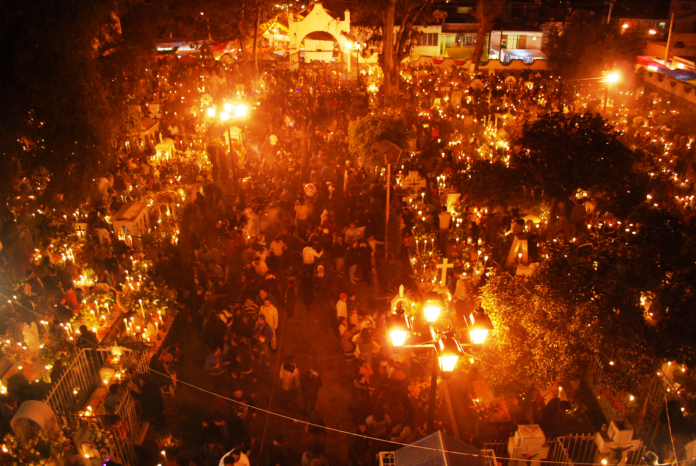
CULLMAN, Ala. – As many in Cullman prepare for the now largely social celebration of Halloween, and the area’s large Catholic population prepares for All Saints Day (preceded by All Hallows Eve or Halloween) and All Souls Day, the county’s growing Hispanic community brings its own distinct version of the three-day holiday.
St. Bernard Prep School Spanish teacher Elizabeth Barajas and her son Victor Fentanes shared with The Tribune about the history of the Mexican celebration known as Dia de Muertos or “Day of the Dead.”
The celebration of the Day of the Dead is a practice that began in Mexico in the 16th century and shares the history of traditions that formed as a result of the integration of two cultures. Historical and Anthropological studies have verified that the celebration of the dead- friends and family who have passed- is a ceremonial practice in which Catholic and Pre-Columbian traditions coexist. With the passing of the centuries, the traditions born from the mixing of the Spanish and indigenous cultures extended and established themselves throughout Mexico. These traditions remain nearly intact in indigenous villages today, and their development led to the current cultural diversity that forms Mexico’s heritage.
The celebration of the dead is unique and firmly rooted in the nation’s history and heritage. Mexico has been internationally recognized as one of the most important cultural leaders in both North and South America and, as a result, this tradition has been declared as an intangible cultural heritage by UNESCO (United Nations Educational, Scientific and Cultural Organization).
Every culture perceives and celebrates death in a different manner, but this great diversity of perceptions is part of what gives each nation an identity. The celebration of the Day of the Dead is an invaluable cultural heritage; it constitutes a portion of Mexico’s identity.
A special vision of death
This celebration has developed its own vision of death, like other countries have their own. A loved one who has passed is viewed as an individual who has transcended among those still living.
As part of the doctrine known as the Communion of Saints, certain Christian traditions view those who have died as still living in spirit, still conscious of those they left behind and still concerned about us. They are viewed as capable of interceding with God on our behalf, and so they are called on to pray for us in the same way we ask our living friends and family to do. When presented with the idea, native Mexicans, who had traditions of venerating their ancestors, found it easy to accept the notion of continuing to enjoy fellowship with their loved ones beyond this life.
Appealing to the imagination, the Day of the Dead offers a privileged annual reunion between the deceased and their living loved ones, a grand party to celebrate the dead’s transcendence in the lives of their loved ones who still find themselves on Earth. It is a remembrance of our ancestors and a banquet among groups, families and communities, whether an urban neighborhood or a remote village. The important part is to remember those who have passed, and a party for the dead is a way to pay homage to our ancestors.
Officially, according to the Catholic calendar, Nov. 1 is dedicated as All Saints Day and Nov. 2 as All Souls Day. Mexican popular tradition, though, dedicates Nov. 1 to deceased children while Nov. 2 is dedicated to adults and the time when the souls of loved ones return to their homes to spend time with their living relatives.
Altars and skull faces: the culture of the Dia de Muertos
A big part of the Day of the Dead is re-creating its original traditions like family altars, organized ritual spaces, dance, music, song and stories.
Families build altars to honor the dead, decorated with offerings symbolic of gratitude, infinite love, remembrance and respect. Such offerings can consist of but are not limited to: water, candles, religious images, food (especially tamales), “pan de muerto” (a type of sweet bread), flowers, soda, alcoholic beverages, photos of the deceased, and salt. Cempasúchil (Mexican marigold) flowers decorate arches over the altar, and petals are scattered on the ground outside of the home. Copal is burned to guide the dead, and the house is left open to symbolically facilitate their entrance. The altar is constructed with two levels, one representing Earth and the other Heaven. An optional third level that represents Purgatory can be made. There are some altars made with seven levels, which represent the steps to reach eternal peace.
The most important elements have a unique significance: the arch that surrounds the altar with cempasúchil flowers signifies the solar cycle and the sun as the provider of life. The photo of the deceased is placed on the altar’s highest level and signifies the spirit of the relative who will visit. The “papel picado” (a decorative paper craft) is customarily purple, which represents mourning for Christians, and orange, signifying mourning for Aztecs. Cempasúchil flower petals scattered on the ground in the form of a path represent guidance for the dead. Salt serves as an element of purification so the symbolic body can remain intact when it returns next year. Ashes shaped in the form of a cross represent the purification of a soul’s sins. Candles serve to guide the departure of the deceased from the house. Skulls made of sugar signify death and “pan de muerto” represents fellowship. Lastly, water signifies purity and helps to quench the soul’s thirst.
For many non-Hispanics, the most immediately recognizable symbol of the Day of the Dead is the skull-themed face paint worn by revelers. The tradition is fairly recent and can be traced to artist José Guadalupe Posada’s “La Calavera Catrina,” or “the elegant skull.” Created around 1910 (though the title would not come along until the 1940’s), the figure of a smiling skeleton in a fancy flowered French style lady’s hat was a satirical graphic commentary on native Mexicans who neglected their indigenous cultural heritage in an effort to seem more cultured and European, and on the current government of that time, which was encouraging such changes throughout the country. The image became associated with the Day of the Dead in Mexican popular culture, and an icon was born. Today, dressing up in fancy, even gaudy, outfits and painting one’s face in a skull theme, along with the display of Catrina dolls and images, are accepted components of the celebration.
“Coco” actually got a lot of things right
The 2017 Disney/Pixar movie “Coco” was the introduction to the Dia de Muertos for a great number of non-Hispanics, and it is a surprisingly great example of the utilization of aspects of the Day of the Dead; many of the elements portrayed accurately represent this tradition. The celebration of the Day of the Dead is an incredibly important festivity for the Mexican people. It is a symbol of identity and cultural heritage of past centuries. It is a day in which the entire nation celebrates and remembers its dead joyfully with music, food, songs (including mariachis) and art among other things. Above all else, it is a day each year in which, with profound love, the arrival of our ancestors is greatly anticipated along with the feeling of protection they bring to us from beyond. Their arrival reaffirms the living’s dependence on the dead, leaving the sensation of a night whose darkness is full of life.
Photo of San Andres Apostol Cemetery:
Photo courtesy of Thelmadatter
View the license here.
Copyright 2020 Humble Roots, LLC. All Rights Reserved.



























